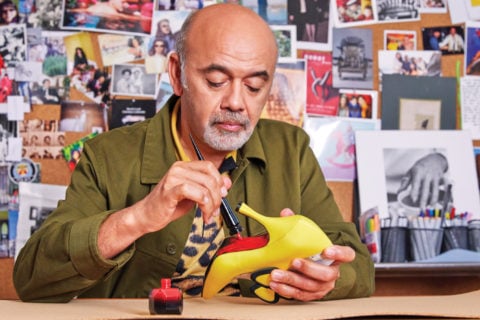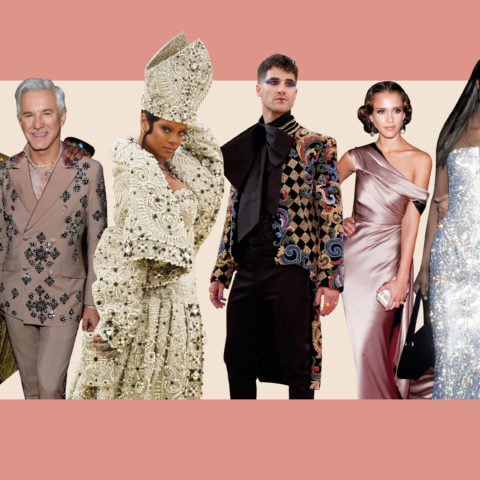Christian Louboutin on Passion, Creativity and the Colour Red
“Everything starts with a sketch; you can draw your own universe and create things that don’t exist.”
Christian Louboutin wants his money back — figuratively speaking. He’s calling from California, which is usually sunny but for the past few days has had nothing but clouds and rain. “Isn’t it the Cali guarantee that you’ll have nice weather?” I ask him from Toronto, sunshine pouring in from the window. “It’s true,” the shoe designer exclaims in his very thick French accent. “I’m going to complain.” Otherwise he has very little to gripe about, given that he has created one of the most iconic fashion brands in history.
RELATED: The Significance of Barbie’s Birkenstocks
There is no sole more famous than that of a Christian Louboutin. Since opening his doors in 1992, the Frenchman has risen to the ranks of pop-culture icon thanks to his whimsical and often theatrical approach to footwear. His designs have ranged from black patent pumps to barbed-wire boots and been spotted everywhere and on everyone, from Carrie Bradshaw in Sex and the City to Blake Lively on the steps of the Met Gala. And at the heart of Louboutin’s success is the red sole, which is celebrating its 30th anniversary.
But before all that, Louboutin was simply a young boy in the ’70s trying to survive living with his parents and three sisters in Paris. “I was the male Cinderella,” he jokes. “I love them, but they were my ugly stepsisters.” Don’t misunderstand him — they are technically his half-siblings; Louboutin found out later in life that his biological father was Egyptian (hence his home in Luxor, along with residences in France and Portugal). This is just how Louboutin talks: He loves a dramatic statement.
Like calling his sisters “witches” when he explains how, in lieu of babysitting, they used to drop him off at the Museum of African and Oceanic Arts (now closed). It was there that he spotted a drawing of a spiky stiletto from the ’50s that changed his life. “Looking at it, I didn’t understand what it was because I was used to women wearing platforms,” he recalls. “But it made me understand that basically everything starts with a sketch; you can draw your own universe and create things that don’t exist. Then eventually you can give them a reality.”
View this post on Instagram
Years later, another piece of art inspired a big breakthrough: Andy Warhol’s flower series. As fashion folklore goes, Louboutin started working on a prototype of a pop-art shoe after his Paris boutique was made famous by an American fashion editor in the early ’90s. The designer immediately knew something was missing when the pink heels, adorned with an animated cloth blossom, arrived from his atelier in Italy. “The style was good, but with the black soles, the shoes lost their vitality,” he says. Looking for an answer, he noticed that his assistant was painting her nails and asked to borrow her red nail polish. At first, she said no, because “she needed to finish her hand,” he recalls. “So we had a bit of a battle over it, and I said, ‘Listen, I’ll buy you a new one,’” adds Louboutin, laughing. Eventually she relented, and the brand’s emblem was born.
When asked if he still has the historic bottle, Louboutin is quick to say no. “I never thought it would become something important to me,” he says. “In the beginning, I planned to change the colour of the sole every season. When I drew the red, winter was coming, so I also considered using green to have Christmas colours. Then I thought, ‘If you don’t like colours, you definitely don’t like green, orange, yellow, purple or whatever. But you will still like red.’”
View this post on Instagram
For Louboutin, red is a colour but also a non-colour. “Women used to tell me ‘I only wear black,’ and I would say ‘Yes, but you have a bit of red on you,’ and they would say ‘Red is different.’ So I realized quite quickly that red was a neutral like how gold is a neutral.” He also calls it the colour of “anything.” Chinese New Year and Spanish bullfights are the first examples he cites; historically, however, red has symbolized everything from blood, power and life to luck and lust. Consider the diversity of the following examples: Mary Queen of Scots, who hid a dark-scarlet bodice and petticoat under her sombre black satin gown for her execution, the bonnet rouge of the French Revolution, Julia Roberts’s gown in Pretty Woman.
With these revolutionaries in mind, does Louboutin have any plans to shake up the red sole and try something different? “I would be in trouble if I did,” he laughs, referencing his 2018 win to trademark it. He mentions that he once introduced a light-blue sole as part of a bridal collection so “brides could have something new and something blue,” but it didn’t last.
Instead, Louboutin keeps returning to red. “I owe a lot of things to that colour, so I’m not about to piss on it,” he jokes. “But I would say that, for me, the first meaning of red is passion. And what drives me to continue my work is my passion.” Walking on sunshine, indeed.
This article first appeared in FASHION’s September 2023 issue. Find out more here.








